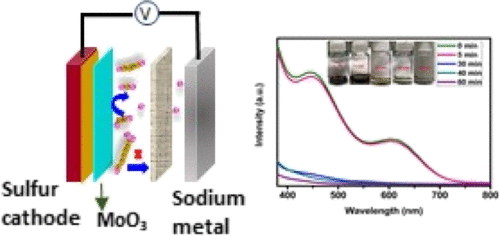当前位置:
X-MOL 学术
›
J. Phys. Chem. C
›
论文详情
Our official English website, www.x-mol.net, welcomes your
feedback! (Note: you will need to create a separate account there.)
Core–Shell Cathode Design with Molybdenum Trioxide as the Electrocatalytic Trapping Layer for High-Energy Density Room-Temperature Sodium Sulfur Batteries
The Journal of Physical Chemistry C ( IF 3.3 ) Pub Date : 2020-03-25 , DOI: 10.1021/acs.jpcc.9b10825 Ajay Piriya Vijaya Kumar Saroja 1, 2 , Kamaraj M. 2 , Ramaprabhu Sundara 1
The Journal of Physical Chemistry C ( IF 3.3 ) Pub Date : 2020-03-25 , DOI: 10.1021/acs.jpcc.9b10825 Ajay Piriya Vijaya Kumar Saroja 1, 2 , Kamaraj M. 2 , Ramaprabhu Sundara 1
Affiliation

|
Room-temperature sodium sulfur batteries are receiving immense attention because of their low cost and higher energy density compared to lithium ion batteries. The key challenges of room-temperature sodium sulfur batteries are the polysulfide shuttling and sluggish reaction kinetics of polysulfide conversion. To mitigate these two issues, molybdenum trioxide is chosen to catalytically covert the sodium polysulfide as well as chemically anchor the polysulfide toward the cathode. This proof of concept is implemented and realized through the change in the design of the cathode wherein the sulfur is used as the core layer and MoO3 is used as the catalytic shell layer for shielding the polysulfide migration. The core–shell design of the cathode delivers a specific capacity of 1198 mA h g–1 at a current density of 50 mA g–1, which is about 4.2 times enhancement in specific capacity when compared to the single-layered cathode with a cycling stability of 1000 cycles. The core–shell cathode design offers a more stable open circuit potential for over 20 days and low charge transfer resistance. The enhancement in specific capacity is attributed to the formation of polythionate complexes through the reaction of MoO3 with the polysulfides which helps in strong binding of soluble species as evident from the spectroscopy studies. This is the first attempt of utilizing catalytic MoO3 for binding sodium polysulfide in room-temperature sodium sulfur batteries and will provide a new practical approach for the development.
中文翻译:

三氧化钼作为高能密度室温钠硫电池的电催化捕获层的核-壳阴极设计
与锂离子电池相比,室温钠硫电池由于成本低和能量密度高而受到广泛关注。室温钠硫电池的关键挑战是多硫化物的穿梭和多硫化物转化的反应动力学缓慢。为了缓解这两个问题,选择了三氧化钼以催化隐蔽多硫化钠以及将多硫化物化学固定在阴极上。通过改变阴极的设计来实现和实现这一概念证明,其中将硫用作芯层,将MoO 3用作催化壳层以屏蔽多硫化物的迁移。阴极的核壳设计可提供1198 mA hg –1的比容量在50 mA g –1的电流密度下,与单层阴极的循环稳定性为1000次循环相比,比容量提高了约4.2倍。核-壳阴极设计提供了超过20天的更稳定的开路电势和低的电荷转移电阻。比容量的提高归因于通过MoO 3与多硫化物的反应形成的多硫酸盐配合物,这有助于使可溶物质牢固结合,这从光谱研究中可以看出。这是在室温钠硫电池中利用催化MoO 3结合多硫化钠的首次尝试,将为开发提供新的实用方法。
更新日期:2020-03-26
中文翻译:

三氧化钼作为高能密度室温钠硫电池的电催化捕获层的核-壳阴极设计
与锂离子电池相比,室温钠硫电池由于成本低和能量密度高而受到广泛关注。室温钠硫电池的关键挑战是多硫化物的穿梭和多硫化物转化的反应动力学缓慢。为了缓解这两个问题,选择了三氧化钼以催化隐蔽多硫化钠以及将多硫化物化学固定在阴极上。通过改变阴极的设计来实现和实现这一概念证明,其中将硫用作芯层,将MoO 3用作催化壳层以屏蔽多硫化物的迁移。阴极的核壳设计可提供1198 mA hg –1的比容量在50 mA g –1的电流密度下,与单层阴极的循环稳定性为1000次循环相比,比容量提高了约4.2倍。核-壳阴极设计提供了超过20天的更稳定的开路电势和低的电荷转移电阻。比容量的提高归因于通过MoO 3与多硫化物的反应形成的多硫酸盐配合物,这有助于使可溶物质牢固结合,这从光谱研究中可以看出。这是在室温钠硫电池中利用催化MoO 3结合多硫化钠的首次尝试,将为开发提供新的实用方法。











































 京公网安备 11010802027423号
京公网安备 11010802027423号